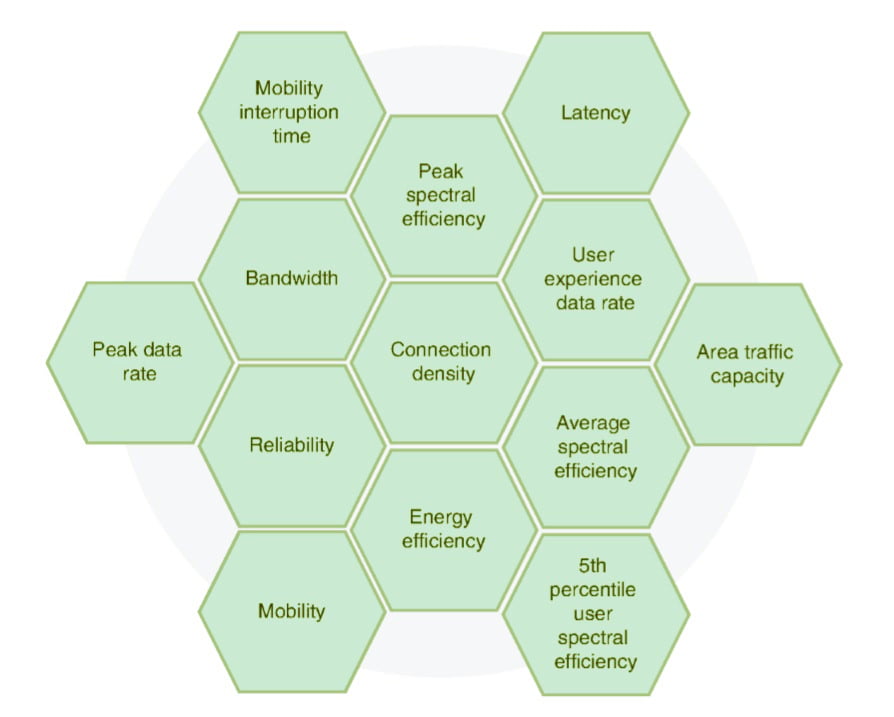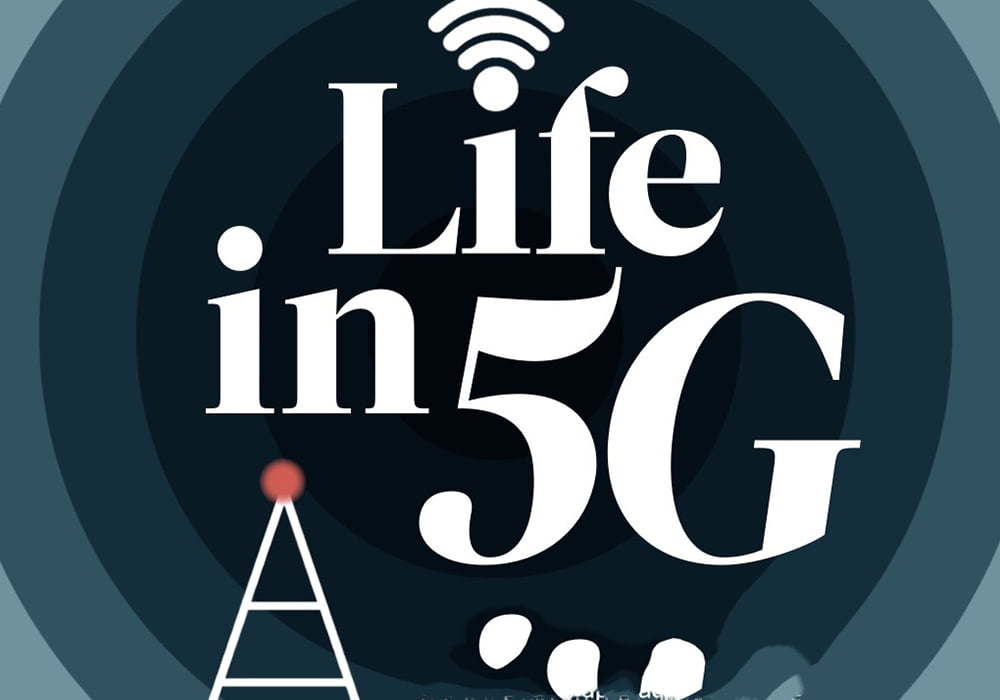5g Technology Explained and Benefits: The term 5G alludes to the fifth era of mobile communication frameworks. They belong to the next major phase Of mobile telecommunications standards beyond the current 4G networks that will comply with the forthcoming International Mobile Telecommunications (IMT)-2020 requirements Of ITU-R (radio section Of the International Telecommunications Union).
5G provides much faster data rates with very low latency compared to the current systems up to 4G. It thus facilitates the adaptation of highly advanced services in a wireless environment.
5g Technology Explained and Benefits, Factory of The Future
Peak Data Rate
The peak data rate (b/s) refers to the maximum possible data rate assuming ideal, error-free radio conditions that are assigned to a single mobile station with all the available radio resources, excluding the resources for physical layer synchronization, reference signals, pilots, guard bands, and guard times.
The term W represents bandwidth, Esp, referring to a peak spectral efficiency, the user’s peak data rate Rp = WEsp. The total peak spectral efficiency is obtained by summing the value per each applicable component frequency bandwidth.
This requirement is meant to evaluate the evolved Multimedia Broadband (eMBB) use case, for which the minimum downlink peak data rate is 20 Gb/s whereas the value for uplink is 10 Gb/s.
Peak Spectral Efficiency
The peak spectral efficiency (b/s/Hz) normalizes the peak data rate of a single mobile station under the same ideal conditions over the utilized channel bandwidth. The peak spectral efficiency for the downlink is set to 30 b/s/Hz, whereas the value for the uplink is 15 b/s/Hz.
User Experienced Data Rate
The user-experienced (UX) data rate is obtained from the 5% point of the CDF (cumulative distribution function) of the overall user throughput, i.e. correctly received service data units (SDUs) of the whole data set in layer 3 during the active data transfer.
If the data transfer takes place over multiple frequency bands, each component bandwidth is summed up over the relevant bands, and the UX data rate Ruser = WEs-user. This equation refers to the channel bandwidth multiplied by the fifth percentile user spectral efficiency. The ITU requirement for the UX data rate in downlink is 100 Mb/s, whereas it is 50 Mb/s for uplink.
Fifth Percentile User Spectral Efficiency
The fifth percentile user spectral efficiency refers to the 5% point of the CDF of the normalized user data throughput. The normalized user throughput (b/s/Hz) is the ratio of correctly received SDUs in layer 3 during the selected time divided by the channel bandwidth. This requirement is applicable to the eMBB use case, and the required values are, for downlink and uplink, respectively, the following:
- Indoor hotspot. 0.3 b/s/Hz (DL) and 0.21 b/s/Hz (UL).
- Dense urban. 0.225 b/s/Hz (DL) and 0.15 b/s/Hz (UL), applicable to the Macro TRxP (Transmission Reception Point) layer of the Dense Urban eMBB test environment.
- Rural. 0.12 b/s/Hz (DL) and 0.045 b/s/Hz (UL), excluding the LMLC (low mobility large cell) scenario.
Average Spectral Efficiency
Average spectral efficiency can also be called spectrum efficiency, as has been stated in ITU Recommendation ITU-R M.2083. It refers to the aggregated throughput, taking into account the data streams of all the users.
More specifically, the spectrum efficiency is calculated via the correctly received SDU bits on layer 3 during a measurement time window compared to the channel bandwidth of a specific frequency band divided further by the number of TRxPs, resulting in the value that is expressed in b/s/Hz/TRxP.
The ITU requirement values are, for downlink and uplink for eMBB use case, respectively, the following:
- Indoor hotspot. 9 b/s/Hz/TRxP (DL) and 6.75 b/s/Hz/TRxP (UL).
- Dense urban for macro TRxP layer. 7.8 b/s/Hz/TRxP (DL) and 5.4 b/s/Hz/TRxP (UL). • Rural (including LMLC). 3.3 (DL) and 1.6 (UL).
Area Traffic Capacity
The area traffic capacity refers to the total traffic throughput within a certain geographic area and is expressed in Mb/s/m2. More specifically, the throughput refers to the correctly received bits in layer 3 SDUs during a selected time window. If the bandwidth is aggregated over more than one frequency band, the area traffic capacity is a sum of individual bands. The target value for the area traffic capacity is set to 10 Mb/s/m2.
One of the Best 5g Technology Explained and Benefits is Latency
The user plane latency refers to the time it takes for the source sending a packet in radio protocol layer 2/3 to reach its destination on the respective layer. The latency is expressed in milliseconds. The requirement for the user plane latency is 4 ms for the eMBB use case, whilst it is 1 ms for ultra-reliable low latency communications (URLLCs).
The assumption here is an unloaded condition in both downlink and uplink without other users than the observed one whilst the packet size is small (zero payloads and only inter-net protocol [IP] header).
The control plane latency, in turn, refers to the transition time it takes to change from the idle stage to the active stage in the URLLC use case. The requirement for the control plane latency is a maximum of 20 ms, and preferably 10 ms or less.
Editor Recommendation:
The things you need to know about 5g.What is 5g?
5g Architecture For The Factory Of The Future
Connection Density
Connection density refers to the total number of 5G devices that can still comply with the target QoS (quality of service) level within a geographical area which is set to 1 km2, with a limited frequency bandwidth and the number of the TRxPs, the variables being the message size, time and probability for successful reception of the messages.
This requirement applies to the massive machine-type communications (MTC) use case, and the minimum requirement for the connection density is set to 1 000 000 devices per km2.
Energy Efficiency
the high-level definition of the 5G energy efficiency indicates the capability of the radio interface technology (RIT) and set of RITs (SRIT) to minimize the radio access network (RAN) energy consumption for the provided area traffic capacity.
Furthermore, the device energy efficiency is specifically the capability of the RIT and SRIT to optimize the consumed device modem power down to a minimum that still suffices for the adequate quality of the connection.
For the energy efficiency of the network as well as the device, the support of efficient data transmission is needed for the loaded case, and the energy consumption should be the lowest possible for the cases when data transmission is not present.
For the latter, the sleep ratio indicates the efficiency of power consumption. Energy efficiency is significant for the eMBB use case, and the RIT and SRIT must have the ability to help a high sleep ratio and long sleep term.
Reliability
The reliability of 5G, in general, refers to the ability of the system to deliver the desired amount of packet data on layers 2 and 3 within the expected time window with high success probability, which is dictated by channel quality. This requirement is applicable to the URLLC use cases.
More specifically, the reliability requirement in 5G has been set to comply with the successful reception of a 32-bit packet data unit (PDU) on layer 2 within a 1 ms period with a 1 x 10-5 success probability. This requirement is applicable to the edge of the cell in urban macro-URLLC, assuming 20 bytes of application data and relevant protocol overhead.
Mobility
The SG mobility requirement refers to the maximum mobile station speed in such a way that the minimum QoS requirement is still fulfilled. There is a total of four mobility classes defined in SG:
- Stationary with 0 km/h speed;
- Pedestrians with 0-10 km/h;
- Vehicular with 10-120 km/h;
- High-speed vehicular with speeds of 120-500 km/h. The applicable test environments for the mobility requirement are indoor hotspot eMBB (stationary, pedestrian), dense urban eMBB (stationary, pedestrian, and vehicular 0-30 km/h), and rural eMBB (pedestrian, vehicular, high-speed vehicular).

Mobility
Interruption Time The mobility interruption time refers to the duration of the interruption in the reception between the user equipment (UE) and base station, including RAN procedure execution, radio resource control (RRC) signaling, or any other messaging. This requirement is valid for eMBB and URLLC use cases and is set to 0 ms.
Bandwidth
The bandwidth in 5G refers to the maximum aggregated system bandwidth and can consist of one or more radio frequency (RF) carriers.
The minimum supported bandwidth requirement is set to 100 MHz, and the RIT/SRIT shall support bandwidths up to 1 GHz for high-frequency bands such as 6 GHz. Furthermore, the ray tracing (RT)/SRIT shall support scalable bandwidth (Picture Above).
If you understand the 5g Technology Explained and Benefits, please give us feedback in the comment section.
